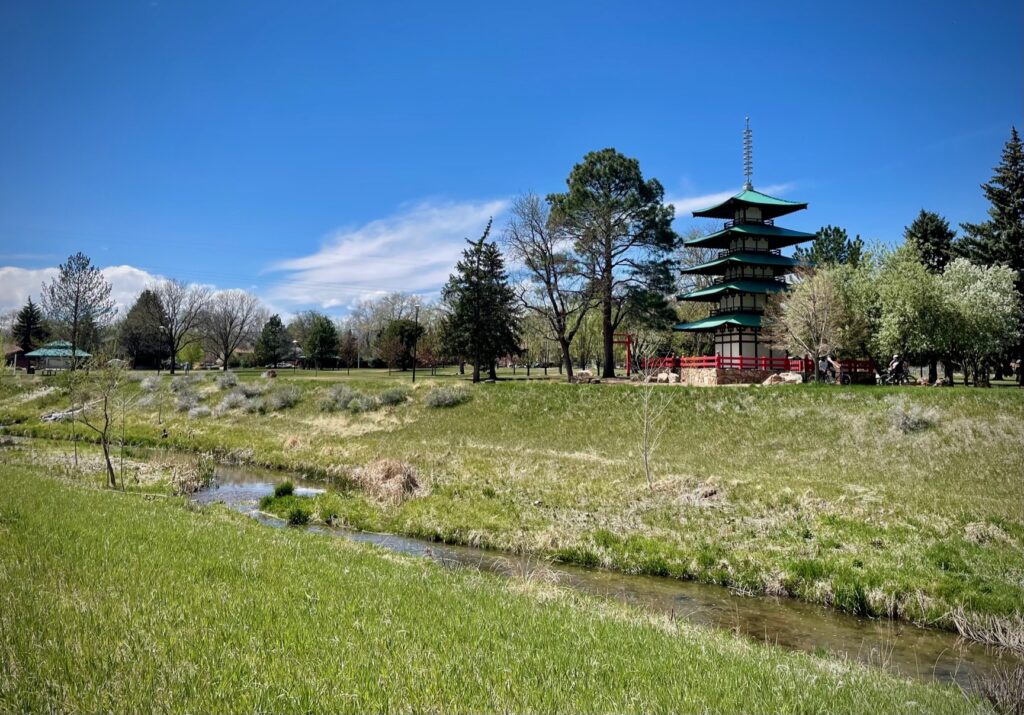In honor of Asian American Pacific Islander Heritage Month, we invite you to learn the story behind the Tower of Compassion on the banks of Left Hand Creek in Longmont’s Kanemoto Park.
Despite a dry climate, the Longmont area is blessed with rich soil and access to water from the St. Vrain Creek and Left Hand Creek, which allowed for a productive farming industry to flourish. In 1903, the construction of the Great Western Sugar Company factory in Longmont (originally the Longmont Sugar Company) created local demand for sugar beets, which grow well with irrigation. Sugar beet farming and refining were two of the most profitable industries in Colorado at the time and many immigrants came to the Longmont area to work in the sugar beet fields.
The first Japanese farmers arrived in the St. Vrain Valley between the years of 1915 and 1920, including Goroku Kanemoto, a young man from Hiroshima. He first emigrated to Mexico in 1908 and began working for the railroad. On a journey to Canada, he stopped in Denver and decided to stay, settling in Longmont to work in the sugar beet fields.
Goroku married Setsuno Nakasaki, also from Hiroshima. Together, they rented a farm near Terry Lake where they grew sugar beets and vegetables and raised three children.
Sadly, in 1935, Goroku died in an automobile accident. His oldest son Jimmie then took over the family business along with his younger brother George. The brothers saved enough money to be able to purchase land in south Longmont, close to the confluence of Left Hand Creek and the St. Vrain Creek, where they farmed for nearly 30 years. Even during the Dust Bowl and Great Depression, the Kanemotos’ farming business continued to grow and prosper. Jimmie and George bought more land over the years, growing their assets to 340 acres.
When WWII began in 1941, the sugar beet harvest was considered crucial to the war effort, creating even more demand for the product. In addition, Colorado’s governor at the time, Ralph Carr, was the only Western governor opposed to Japanese internment and so the area became somewhat of a safe haven for Japanese-Americans to live peacefully and find work in the sugar beet fields.
In the mid-1960s, Jimmie and George moved out of the farming business and opened Kane Manufacturing and Supply Company that sold irrigation equipment. The family farm ultimately became a 700-home subdivision, known as Southmoor Park. The brothers donated a portion of their farm along the banks of Left Hand Creek to the City of Longmont for Kanemoto Park, named for their father. They also donated land for a fire station, St. Stephen’s Episcopal Church, the St. Vrain Greenway, a Buddhist temple, and Burlington Elementary School.
In 1972, the brothers commissioned a five-story Japanese style pagoda in Kanemoto Park and dedicated it to the City of Longmont for the kindness the community showed their family during World War II. Named the Tower of Compassion, each of its five levels represent a different virtue of compassion – Love, Empathy, Understanding, Gratitude, and Selfless Giving. The sign alongside the tower reads: “Compassion is living the life of love, empathy, understanding and gratitude of all things, and giving selflessly of oneself for the happiness of all beings.”
When Kanemoto Park and the Tower of Compassion were damaged in the 2013 flood of Left Hand Creek, the community of Longmont came together to restore the important landmarks of the city, truly embodying the meaning behind the tower. Today, the park and its tower are beautiful reminders of the Kanemotos’ story of courage, ambition, resilience, innovation, and, last but not least, compassion.
Earlier this year, the Tower of Compassion celebrated its 50th anniversary. Read an article and see historic photos of the Kanemoto family in this Longmont Leader article. And if you ever pass through Longmont, be sure to stop at Kanemoto Park to visit the Tower of Compassion!
